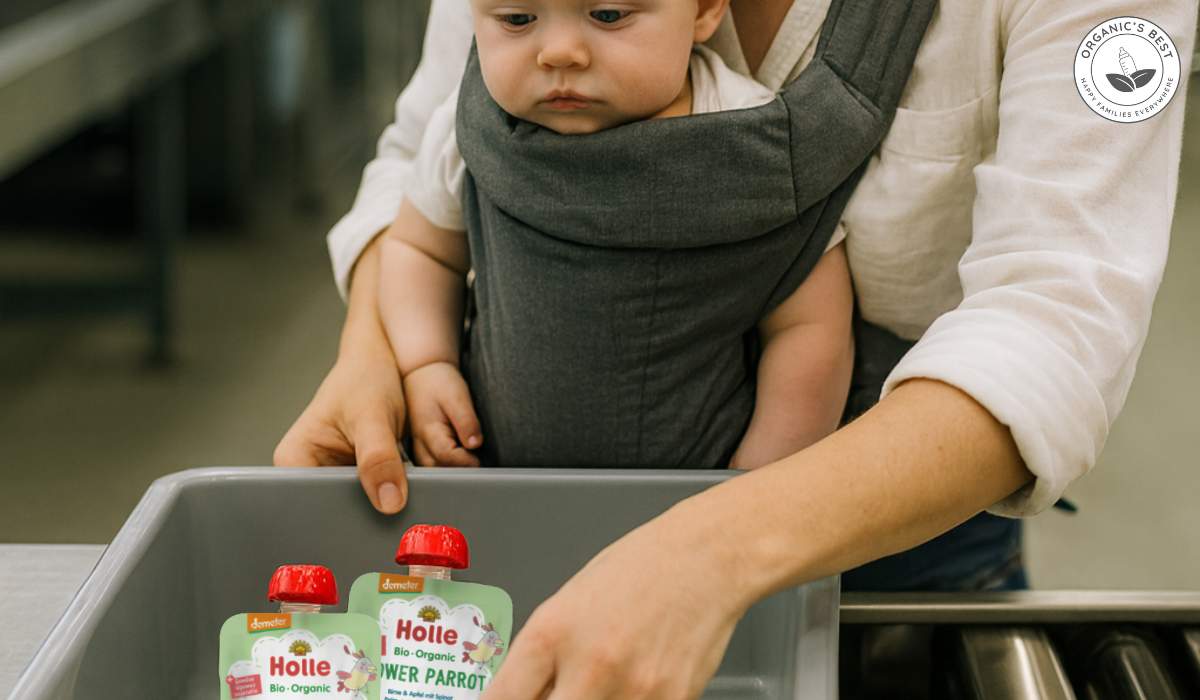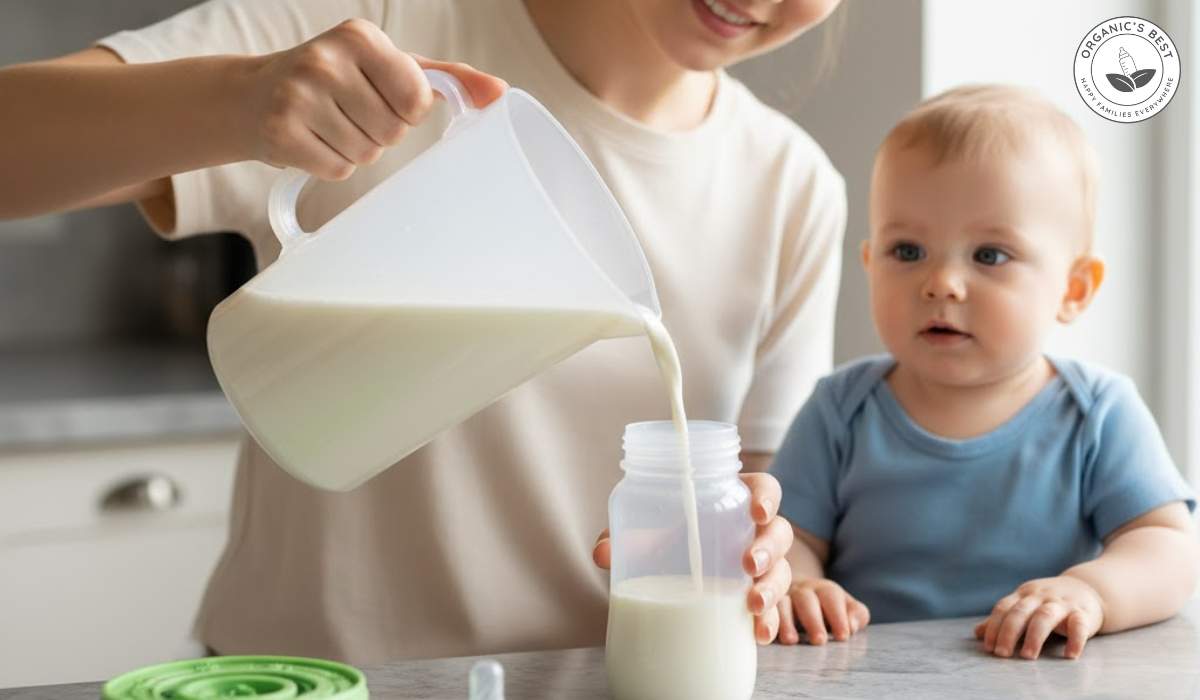Click to Get 2 FREE Boxes/Cans
Click to Get 2 FREE Boxes/Cans
Only New Customers! Click HERE to Get 2 Extra Boxes/Cans for Free With Your First Order.
Only New Customers! Click HERE to Get 2 Extra Boxes/Cans for Free With Your First Order.
BABY FORMULA
Offering new parents top-quality European infant formula from renowned brands like HiPP, Holle, Kendamil, and more. If you’re uncertain about which product to choose, our Formula Finder can help you make the best decision for your baby.
Baby Food
Offering new parents a premium selection of European baby foods, including jars, pouches, cereals, and snacks from esteemed brands like HiPP and Holle.
Can You Mix Formula and Breast Milk?
by Agustina Fernandez January 19, 2023 6 min read

Table of Contents
Feeding your baby is no doubt one of the most important aspects of motherhood, and while there are a number of ways to feed them, the top priority is making sure your little one is getting all of the vitamins and nutrients that they need to grow healthy and strong.
Their tiny body is constantly developing and strengthening during their early years, so it is crucial that they are eating enough. Sometimes, solely relying on either infant formula or breast milk alone is not a suitable option for a number of reasons.
Keep reading to get the scoop on mixing breast milk and formula.
Can you mix breastfeeding and formula feeding?

In short, the answer is yes. There are various circumstances that would lead a parent to feed their little one with both breast milk and formula. These circumstances may include having a low milk supply, pain associated with breastfeeding, the baby's feeding preference, the parent's comfort level, and lifestyle factors such as going back to work.
Regardless of the reason, there is no need to choose one or the other, there are safe and healthy ways to switch to mixed feeding.
Although, if you are struggling to produce enough breast milk, it may be beneficial to look at ways to increase your supply before adding formula to the mix, as exclusive breastfeeding for the first 6 months is recommended by the AAP. Of course, we know that is not always an option for many new mothers, and in this case, formula is a perfectly healthy and safe alternative.
Some ways to increase breast milk production may include massaging the breasts, breastfeeding more frequently, pumping between feedings, and eating foods and supplements that may increase your milk supply. A lactation consultant can also be a valuable resource as they are nurses who specialize in breastfeeding.
If you decide that the best course of action is to start mixing breast milk with formula then it is always best to consult a health professional to more about making this transition such as how to introduce it, the frequency of feedings, and how much breast milk and formula should be used in each feeding.
Combination Feeding: Pros and Cons
There are many benefits and a few potential downsides to the mixed feeding method. Let's look at the pros and cons.

Pros of combination feeding
- Both you and your baby can carry on enjoying the benefits of breastfeeding
- A convenient option for parents with a busy lifestyle or new moms returning to work
- Formula can supplement a low milk supply
- There are many fantastic formulas on the market that accommodate a range of dietary needs
- Mixing the two allows your baby to adjust to the taste of formula gradually (This is especially beneficial if you are planning to eventually transition to using only formula)
- Can help babies get extra nutrition

Cons of combination feeding
- Potential to waste breast milk if your baby doesn't finish the whole bottle in time
- Your supply may diminish if you are breastfeeding or pumping less frequently
- Health risks associated with not preparing formula properly
- The baby may start to prefer a bottle instead of feeding from the breast
- This may lead to breasts getting overfull which can be painful
It is important to choose a high-quality formula to mix with breast milk, as a way to give your baby the best nutrition. Parents all over the world are choosing to feed their babies with European infant formulas because of their standards in terms of quality and control. They are made with high-quality ingredients, are free from unwanted additives such as sucrose and corn syrup, and are made without the use of GMOs, antibiotics, pesticides, chemicals, and preservatives.
Brands like HiPP, Holle, Lebenswert, Löwenzahn Organics, and Jovie make excellent formulas that are sure to meet your child's nutritional needs.
Can you mix formula and breast milk together in the same bottle?
For convenience's sake, it may be beneficial to mix breast milk and formula together in the same bottle, in the case where you are considering quitting breastfeeding altogether. Alternatively, if you are going to be supplementing with formula, it may be a better option to keep formula and breastfeeds separate for a couple of reasons. The reasons for this are:
- To keep your breast milk from going to waste if your baby doesn’t finish the entire bottle in one feeding.
- To keep the experience of breastfeeding, which is a beneficial and intimate moment that can strengthen the bond between mother and baby.
If you are planning to transition to formula you should do this gradually by following the recommended ratios. The entire transition period usually takes around 2 weeks, where formula and breast milk will be mixed during this stage, which can easily be done in one bottle. Here is how much formula should be added to feedings:

- ¾ : ¼ for the first 4 days
- ½ : ½ for the next 4 days
- ¼ : ¾ for the next 4-5 days or even one week
- Finally, 100% baby formula
What are the advantages of mixing formula and breast milk?
As mentioned above, mixing breast milk and formula can be a convenient way to make sure your baby is getting all the nutrients they need to grow big and strong. Some babies are pickier than others and prefer certain feeding methods.
Mixing both gives your baby the comfort of what they already know while getting them used to something new. This is especially important for babies who are transitioning to formula feeding and have to get used to the new textures and flavours.
Being able to prepare both breast milk and formula in one bottle makes for an easy feed and an easy clean. As long as you follow safety guidelines and recommended instructions, this method can be a great asset in your baby feeding toolbox.
What are the risks of mixing formula and breast milk?
Mixing breastmilk with breast milk can be beneficial for both mother and baby, but there are still risks to consider when introducing this feeding method. If done correctly these risks can be managed.
As mentioned, it is best to do this transition gradually to get your little one used to the new routine and give their tiny bodies time to adjust. Not only does this slow transition benefit the baby, but it can also help mothers continue to produce enough milk, as not giving your body time to adjust may noticeably reduce the milk supply.
The biggest risk associated with the mixing of formula and breast milk is in the preparation of the bottle. Formula should always be prepared first according to the instructions on the package or canister prior to adding breast milk. While multiple kinds of formula can be used for this method, it is important that powdered infant formula is not added directly to breast milk.
In addition, if the entire bottle is not consumed during the feeding, anything left should be discarded. This may deter some from using this method as it can waste breast milk.
How to mix breast milk and formula?

Depending on the type of formula you are using, the preparation differs slightly. For ready-to-feed formula, you can add the formula directly to a bottle of breast milk, but when it comes to powdered or concentrated liquid formula, make sure you prepare the formula first according to the instructions given prior to adding breast milk. Undiluted powdered or liquid formula should never be added directly to a bottle.
Conclusion
Mixing formula and breast milk can be a great tool to have as a new parent to make sure that your baby is getting the fuel that their body needs, although this should be done mindfully and cautiously to mitigate any risks associated with this type of feeding.
Disclaimer:
Please be aware that this information is based on general trends in babies, and it is not medical advice. Your doctor should be your first source of information and advice when considering any changes to your child’s formula and when choosing your child’s formula. Always consult your pediatrician before making any decisions about your child’s diet or if you notice any changes in your child. Breastfeeding is the best nutrition for your baby because breast milk provides your child with all the essential nutrients they need for growth and development. Please consult your pediatrician if your child requires supplemental feeding. |
Agustina Fernandez
Dr. Agustina Fernandez earned her medical degree from the prestigious Universidad Nacional de Córdoba, Argentina. With a deep-rooted passion for pediatrics, Dr. Fernandez is currently on the path to specializing in children's healthcare. Recently, she has delved into the vital field of infant nutrition. Her research interests include breastfeeding, infant formula, and baby food in little ones’ formative years. Dr. Fernandez's commitment to this area of study underscores her dedication to ensuring the health and well-being of children from their earliest days.
Leave a comment
Comments will be approved before showing up.
Also in Organic Infant Nutrition and Health Blog

Everything You Need To Know About Winter Pregnancy: Essential Tips for Moms-to-be
by Agustina Fernandez December 16, 2025 8 min read
Read More
Can You Bring Baby Food Pouches on a Plane? Essential Tips for Parents
by Agustina Fernandez December 09, 2025 7 min read
Read More
The Formula Pitcher: Is It Safe To Make A Whole Pitcher Of Baby Formula?
by Agustina Fernandez December 02, 2025 8 min read
Read More
Reviewed by Dr. Po-Chang Hsu, MD, MS
-

Dr. Po-Chang Hsu: Medical Reviewer of Organic's Best Blog
Dr. Hsu received his medical degree from Tufts University in Boston, Massachusetts, and holds a Master’s of Science degree from both Harvard University and Tufts University.
